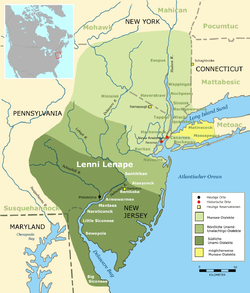Wappinger War
The Wappinger War (1643–1645) was an armed conflict between the Dutch and the Wappinger Confederation in the Dutch colony of Nieuw Nederland (New Netherlands) in North America.
Historical background
In 1638 Willem Kieft was appointed the new general director of Nieuw Nederland by the Dutch West India Company (WIC). He had instructions to restore law, order and morality in the young colony and to make more profit. Kieft showed little intuition in dealing with the indigenous people and due to his merciless harshness he had made enemies of almost all the Indians in the colony in a short time.
In February 1643, a few hundred Wiechquaeskeck fled the attacking Mahican and sought refuge in Pavonia, now Jersey City . The Wiechquaeskeck had previously destroyed an 80-person punitive expedition of the Dutch and they now saw an opportunity to take revenge. On February 25, 1643 they attacked the Indian village at dawn, killed all 120 Wiechquaeskecks and are said to have played soccer with their heads in Fort New Amsterdam . The action went down in history as the Pavonia massacre . Historians have not yet been able to clarify whether the attack really came from Kieft's initiative, but all contemporary sources report that he praised and honored his soldiers for the action.
The war
When the neighboring tribes learned of the Pavonia massacre, the Hackensack and Tappan joined the other Wappinger tribes and raided lonely Dutch farms. This broke out the Wappinger War , also known as the Gouverneur Kiefts War . The Dutch colonists fled to Fort Amsterdam and prepared for a siege. Kieft also made enemies of the Metoac on Long Island when he had maize confiscated from them and three Canar Sea warriors were killed in the process. The war widened and finally twenty tribes united to fight the Dutch:
- New Jersey tribes : Hackensack, Haverstraw, Munsee, Navasink, Raritan, and Tappan
- Tribes east of the Hudson River : Wecquaesgeek, Sintsink, Kitchawank, Nochpeem, Siwanoy, Tankiteke and Wappinger
- Long Island tribes : Lake Canar, Manhattan, Rockaway , Matinecock , Massapequa , Secatoag, and Merrick .
These tribes were able to send a total of about 1,500 warriors into battle, but the Dutch numbered only 250 men and were in great danger of being killed or driven from their colony. The Mohawk and Mahican remained loyal, however, and Kieft hurried to sign a friendship treaty with them in Fort Orange . Nevertheless, the situation for the Dutch remained critical and therefore Willem Kieft offered the English colonists in Connecticut 25,000 guilders for their help in suppressing the uprising. Captain John Underhill , known from the Pequot War , then grabbed two companies consisting of 120 volunteers and Mohegan - scouts , at the beginning of 1644 in the fighting one. The English and Mohegan were feared for their brutal toughness and after a short time the tide turned in favor of the Dutch. The combined Dutch-English force initially turned against the Raritan on Staten Island, but they were able to flee to New Jersey. The Tappan and Hackensack also managed to escape, but the Wappinger and Metoac found no protection and suffered a heavy defeat.
Consequences of war
Although little is known about it today, the Wappinger War was one of the bloodiest and cruelest wars of extermination against the Indians. Together with their allies, the Wappingers had more than 1,600 tribesmen killed. In August 1644, a peace treaty was signed at Fort Orange obliging the Wappinger and Metoac tribes to pay an annual tribute in the form of wampum to the Mahican. The Mahican and Mohawk had no losses of their own, and the Treaty of Fort Orange enabled them to control the wampum trade in western Long Islands and the lower Hudson. When the government in the Netherlands learned of Kieft's policy and the massacres, he was finally replaced in 1647 and they appointed Petrus Stuyvesant as his successor . The Nieuw Nederlands years were numbered, however, as the Dutch colony was taken over by England in 1664 without a fight. In honor of the Duke of York, their future king, the British named their new colony New York .
See also: Timeline of the Indian Wars
Individual evidence
- ^ Journal of New Netherland 1647. Written in the Years 1641, 1642, 1643, 1644, 1645, and 1646 . 1641-1647. Retrieved August 2, 2013.
- ^ Nicholas J. Santoro: Atlas of the Indian Tribes of North America and the Clash of Cultures . iUniverse 2009, ISBN 9781440107955 , p. 410
- ^ Delaware History
- ^ Metoac History
literature
- Bruce G. Trigger (Ed.): Handbook of North American Indians . Vol. 15. Northeast. Smithsonian Institution Press, Washington DC 1978. ISBN 0-16004-575-4
- Wilcomb E. Washburn (Ed.): Handbook of North American Indians. Vol. 4. History of Indian-White Relations. Smithsonian Institution Press, Washington DC 1988. ISBN 0-16004-583-5
